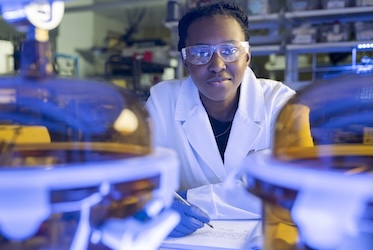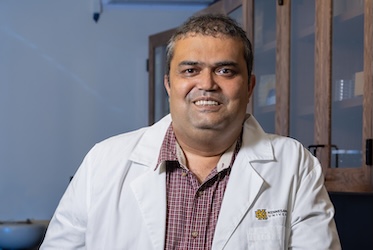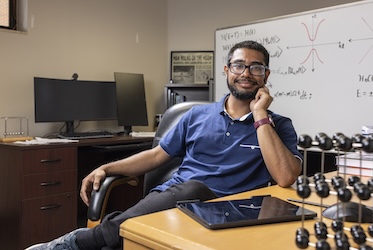
Kennesaw State biology student studies links between soil and tree health
KENNESAW, Ga. | Nov 22, 2024
0.

After graduation from Dunwoody High School, she arrived as a freshman at Kennesaw State University with a strong interest in nature and science, where she was accepted into the First-Year Scholars Program to study longleaf pine forest ecosystems with biology professor Paula Jackson.
“I had never heard of longleaf pines until I met and started working with Dr. Jackson,” Walker said.
Over the next two years she would spend hours in longleaf pine forests with Jackson and other students, taking soil samples and analyzing them back in Jackson’s lab.
Now a junior majoring in biology and minoring in chemistry, Walker has developed some expertise in not only the longleaf pine, but also another endangered tree, the eastern hemlock, which she studied in the prestigious Harvard Forest Summer Research Program in Ecology last summer.
At the 2023 spring Symposium of Student Scholars, Walker presented research on how the microscopic life – the microbiome – in the longleaf pine forest’s soil interacts with and nurtures the plants within it. At the 2024 Symposium her presentation looked at the differences in microbiome DNA between two longleaf pine forests that are near each other, but with older trees in one of them. The finding suggested that the age of the trees affects the makeup of the microbiome.
“It’s obvious that interaction between the roots and what’s happening with the within the soil is very important to the plants,” Walker said.
Nathan Klaus, a Georgia Department of Natural Resources (DNR) biologist who supervised the longleaf pine restoration project at Sheffield Wildlife Management Area said he is happy to see the work that Jackson, Walker, and the other KSU students are doing there.
“There’s a lot going on under the ground in the forest, and it’s something that’s way under studied,” Klaus said.
Jackson’s background is in studying tropical ecosystems which have the highest levels of biodiversity in the world. But just 45 minutes from campus is another ecosystem teeming with a huge variety of plants, animals, fungi, and other life.
“The longleaf pine ecosystem is second only to the tropics in biodiversity, so that was one of the things that attracted my interest,” Jackson said.

Both Native Americans and later settlers maintained longleaf pine forests by regularly burning off the understory. But over many decades, landowners replacing longleaf with other varieties of pine that are not fire resistant, clear-cutting that allowed hardwood trees to take over, as well as urban and suburban sprawl have replaced longleaf pine forests.
Among the effects have been plummeting populations of species like bobwhite quail, red cockaded woodpeckers, fox squirrels, as well as many other animal, plant and insect species, Klaus said. Restoration of longleaf pine ecosystems is among the DNR’s top priorities with acreages totaling in the tens of thousands across the state.
Last summer, Walker turned her attention to the soils supporting another endangered tree, the eastern hemlock, populations of which have been devastated by an invasive Asian insect, the hemlock woolly adelgid.
She participated in a National Science Foundation-sponsored Research Experience for Undergraduates (REU) at Harvard Forest, a research station in Western Massachusetts, which is a department of Harvard University.
“There are two stands of eastern hemlocks at Harvard Forest, and both of them have been infested by the hemlock woolly adelgid, but one was doing better in terms of health than the other,” Walker said. “So, we wanted to see if soil type had anything to do with the differences.”
Much as she has done in Jackson’s lab, in the REU she and other students from around the country helped the scientists from Harvard and elsewhere study the makeup of the soil as part of ongoing research.
In addition to her participation in groundbreaking undergraduate research, Walker is a KSU Journey Honors College student and a part of the Louis Stokes Alliance for Minority Participation (LSAMP) program. For the future, she sees herself going to graduate school and continuing environmental science research.
“Olivia is an all-around impressive student,” Jackson said. “She is quietly consistent and has earned a long list of accomplishments. It’s an honor and a pleasure to work with her.”
– Story by Gary Tanner
Photos provided
Related Stories

First-year Kennesaw State student, author recognized as versed local historian

Chemistry student engaged in sustainable catalyst research through Kennesaw State's First-Year Scholars program

Kennesaw State researchers awarded Department of Energy grant to investigate materials that boost energy-efficient technologies

Kennesaw State physics student awarded Goldwater Scholarship
A leader in innovative teaching and learning, Kennesaw State University offers undergraduate, graduate, and doctoral degrees to its more than 47,000 students. Kennesaw State is a member of the University System of Georgia with 11 academic colleges. The university’s vibrant campus culture, diverse population, strong global ties, and entrepreneurial spirit draw students from throughout the country and the world. Kennesaw State is a Carnegie-designated doctoral research institution (R2), placing it among an elite group of only 8 percent of U.S. colleges and universities with an R1 or R2 status. For more information, visit kennesaw.edu.














